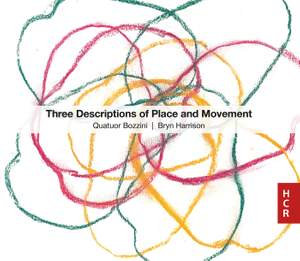Following the success of their 2017?18 collaboration (Bozzini+, Piano Quintet, HCR19), the Bozzini Quartet is reunited with composer Bryn Harrison for Harrison's first string quartet, the three-movement, hourlong Three Descriptions of Place and Movement (2021). A first string quartet is a landmark moment for any composer, but Harrison's feels like a particularly significant arrival: the homogenous instrumentation is ideally suited to the disorienting labyrinthine structures, intricate repetitions, and extended durations that have characterised much of his recent work.
The title's three 'descriptions' are clarified in the names of the movements. Opening, clearing, and burrow?all doubly verbs and nouns?are each embedded with simultaneous motion and stasis. Opening, an unfolding, widening, growing from a single point, as well as the aperture, the crevice, the window that frames the perception of space. Clearing, a kind of purging or scrubbing of materials down to their barren core, or a wide empty space, flat and nondescript, defined by the negative. And burrow, to carve deeper, to dig into, to bury oneself completely, or an underground cocoon, warm, enveloping, home.
Opening is constructed from a complex layering of information that obscures a rather simple harmonic motion: twin chromatic scales, one ascending, one descending, chasing each other in a wrapped double helix that opens, closes, and opens again. Tracing any one pattern, however, is instantly obfuscated by the displacement of successive pitches across octave and player, and by rhythmic patterns that control the speed at which each scale progresses.
After such intense concision and density, Clearing feels dangerously still. The same cross-hatched pitches, once buried by layers of complexity, are now laid bare at a permeating pianissimo. For nearly 25 minutes, the quartet enters in perfect rhythmic unison?two players at a time, six times a bar, at 63 beats per minute?unfolding the same spiral of pitches as before. Once the ear has grown accustomed to traceable consistency, Harrison introduces the first repeats in the work, catching the music mid phrase, insisting it revisit and review its pathways over and over again.
Burrow, the quartet's final and longest movement, features the live quartet playing against two pre recorded versions of itself in canon, repeating the pitches and rhythms from opening verbatim but slowed now to half the original speed. Extensive repetitions, absent in opening, lodge the music further, and what was once a fleeting object becomes a fixated, rotating monolith stretching out in all directions.





